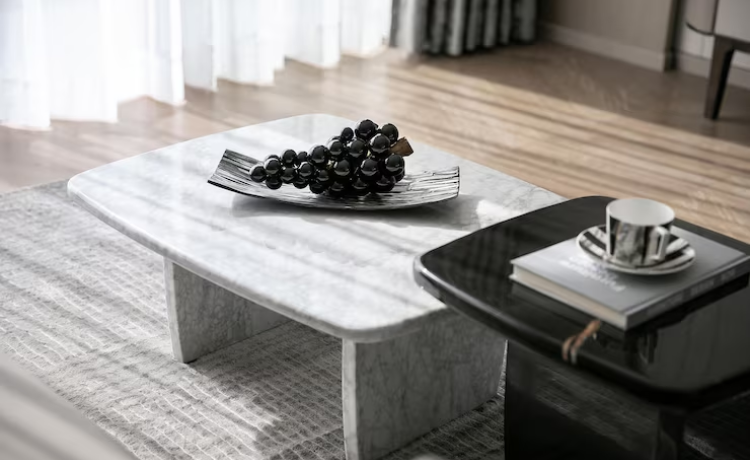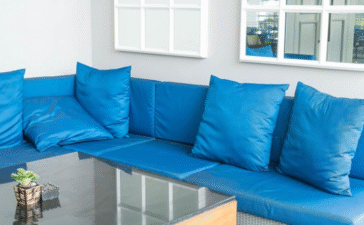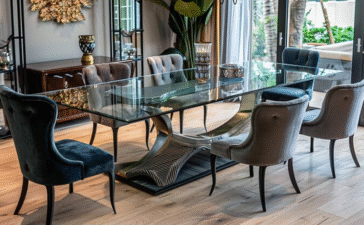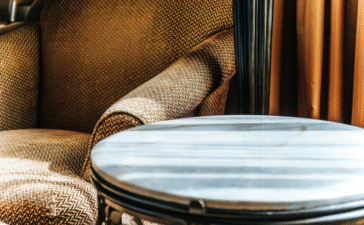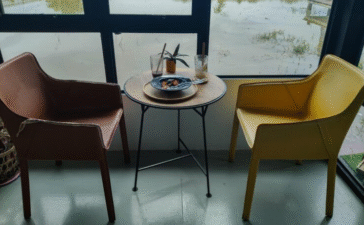Natural stone furniture is making a bold statement in modern homes. Designers and homeowners alike are drawn to materials that feel grounded, organic, and effortlessly luxurious. Among these materials, travertine stands out as a timeless choice that brings warmth, texture, and character to any living space. A travertine coffee table isn’t just a functional piece of furniture. It’s a statement. It anchors your room with a sense of permanence and elegance that few other materials can match. Whether you’re furnishing a minimalist apartment or a spacious family home, travertine offers a natural beauty that works across a range of interior styles.
This guide will walk you through everything you need to know about travertine coffee tables. You’ll learn what makes travertine unique, how to choose the right style and finish for your space, and how to care for your investment so it lasts for decades. You’ll also discover styling ideas, maintenance tips, and insights into why travertine is trending in 2025 interior design.
What Is a Travertine Coffee Table?
Travertine is a type of limestone formed over thousands of years by mineral deposits from natural springs. It has a distinctive porous texture with subtle holes and veining that give each piece a one-of-a-kind appearance. This organic quality is what makes travertine so appealing in furniture design.
Unlike marble, which is metamorphic and typically features bold veining, travertine has a softer, earthier look. It’s less glossy than polished marble and often comes in warm, neutral tones like beige, cream, ivory, and taupe. Some varieties also feature grey or golden hues with streaks of darker minerals running through the surface.
Travertine is denser and more durable than many people assume. When properly sealed and maintained, it holds up well to everyday use. It’s also less expensive than marble, making it an accessible option for those who want the look of natural stone without the luxury price tag.
Compared to quartz or engineered stone, travertine offers something more authentic. It’s a natural material with imperfections, variations, and a tactile quality that synthetic surfaces can’t replicate. For homeowners who value sustainability and craftsmanship, travertine furniture is a smart and stylish choice.
Why Choose a Travertine Coffee Table
There are several compelling reasons to invest in a travertine coffee table. First and foremost is its aesthetic appeal. Each slab of travertine is unique, with natural patterns and color variations that bring depth and character to your living room. This organic material adds warmth to contemporary spaces and complements a wide range of décor styles, from coastal to mid-century modern.
Durability is another major advantage. Travertine is a hard, dense stone that can withstand the demands of daily life. It resists scratches better than wood and doesn’t chip as easily as glass. With proper sealing, it can also resist stains and moisture, making it a practical choice for households with kids or pets.
Travertine is also an eco-friendly material. It’s quarried from the earth and requires minimal processing compared to synthetic alternatives. Choosing natural stone furniture is a step toward more sustainable interior design. Plus, travertine’s timeless aesthetic means you won’t need to replace it as trends come and go. It’s a long-term investment that pays off in both style and function.
Another benefit is versatility. Travertine pairs beautifully with other natural materials like wood, linen, and leather. It works equally well in minimalist settings and more layered, eclectic spaces. Whether your home leans modern, rustic, or transitional, a travertine coffee table can anchor the room without overpowering it.
Popular Shapes and Styles
Travertine coffee tables come in a variety of shapes, each suited to different room layouts and design preferences. Understanding these options will help you choose the right piece for your space.
Round travertine coffee tables are ideal for smaller living rooms or spaces with curved furniture. Their soft edges create a sense of flow and make navigation easier in tight quarters. Round tables also work well in rooms with sectional sofas or multiple seating arrangements, as they allow for easy movement around the table. This shape is particularly popular in Scandinavian and coastal interiors, where gentle curves and natural materials dominate the aesthetic.
Rectangular travertine coffee tables are the most traditional and versatile option. They provide ample surface area for books, trays, and decorative objects. Rectangular tables are especially well-suited to longer sofas or L-shaped seating arrangements. They create a sense of order and balance in the room, making them a go-to choice for classic and contemporary interiors alike.
Square travertine coffee tables offer symmetry and visual stability. They work well in square-shaped rooms or in front of smaller sofas. Square tables are often seen in mid-century modern homes, where clean lines and geometric forms are key design elements. They also pair beautifully with low-profile seating and minimalist décor.
Oval travertine coffee tables combine the softness of a round table with the surface area of a rectangular one. They’re a less common choice, which makes them feel more unique. Oval tables are a great option for transitional spaces that blend traditional and modern elements.
In terms of base design, travertine tables come in several styles. Block bases are solid and sculptural, giving the table a monolithic look that feels grounded and substantial. Pedestal bases offer a lighter, more refined appearance and are often used in smaller or more delicate designs. Mixed-material bases, which combine travertine with metal or wood, add contrast and visual interest. These hybrid designs are especially popular in contemporary and industrial interiors.
Travertine Finishes and Colors
The finish of your travertine coffee table has a significant impact on both its look and its maintenance requirements. There are two primary finishes to consider: polished and honed.
Polished travertine has a smooth, glossy surface that reflects light and enhances the stone’s natural veining. This finish gives the table a more formal, luxurious appearance. It’s a great choice for spaces where you want to create a sense of elegance and sophistication. However, polished travertine is more prone to showing scratches and water spots, so it requires a bit more care.
Honed travertine, on the other hand, has a matte finish with a softer, more understated look. This finish feels more casual and organic, making it well-suited to modern, minimalist, and rustic interiors. Honed travertine is also more forgiving when it comes to everyday wear and tear. It hides scratches and stains better than polished stone, which makes it a practical choice for busy households.
Color is another important consideration. Travertine naturally comes in a range of warm, neutral tones. Beige and cream are the most common, offering a soft, inviting palette that works with nearly any color scheme. Ivory travertine has a lighter, almost white appearance that can brighten up darker rooms. Grey travertine brings a cooler, more contemporary vibe and pairs beautifully with modern furniture and monochromatic décor.
Some travertine slabs feature more pronounced veining or mineral deposits, which add visual interest and movement to the surface. These natural variations are part of what makes travertine so appealing. No two tables will look exactly the same, giving your living room a truly unique centerpiece.
Travertine vs Other Coffee Table Materials
When shopping for a coffee table, it’s helpful to understand how travertine compares to other popular materials. Each option has its own strengths and trade-offs.
Travertine offers a natural, textured appearance that feels organic and warm. It requires moderate maintenance, including sealing and careful cleaning. In terms of cost, it’s more affordable than marble but more expensive than some wood options. Travertine is best suited to modern and organic home styles where natural materials are celebrated.
Marble is more luxurious and features bolder veining than travertine. However, it requires high maintenance and is more prone to staining and etching. Marble coffee tables are typically more expensive and are best reserved for spaces where elegance and formality are priorities.
Wood coffee tables offer a warm, classic look and are relatively easy to maintain. They’re generally less expensive than stone options and work well in traditional and transitional interiors. However, wood is more susceptible to scratches and water damage than travertine.
Glass coffee tables have a sleek, minimal aesthetic that’s perfect for small spaces. They require regular cleaning to avoid fingerprints and smudges. Glass is moderately priced and works well in contemporary and Scandinavian interiors. However, it lacks the tactile warmth and natural character of travertine.
Choosing between these materials comes down to your lifestyle, budget, and design preferences. If you value durability, natural beauty, and sustainability, travertine is an excellent choice.
Styling Ideas for Travertine Coffee Tables
A travertine coffee table is a versatile piece that can be styled in countless ways. The key is to let the natural beauty of the stone take center stage while adding elements that enhance the overall design of your living room.
Pairing your travertine table with neutral rugs and soft textiles creates a cohesive, calming aesthetic. A cream or beige bouclé sofa complements the warm tones of travertine beautifully. Wooden accents, such as a side table or shelving, add warmth and texture to the space.
For a more modern look, create contrast by pairing travertine with black or charcoal furniture. This combination feels sophisticated and contemporary. Add metallic accents, like brass or matte black candle holders, to introduce a touch of elegance without overwhelming the minimalist aesthetic.
Seasonal décor can also bring new life to your travertine coffee table. In spring and summer, fresh flowers in simple ceramic vases add color and vibrancy. In fall and winter, switch to dried grasses, pillar candles, or wooden bowls filled with natural elements like pinecones or stones.
Trays are a practical styling tool that help organize smaller items and create visual balance. A large rectangular tray in wood or metal can hold books, remote controls, and decorative objects while keeping the surface tidy. Layering books, plants, and sculptural objects adds dimension and interest without cluttering the table.
When styling your travertine coffee table, remember that less is often more. The stone itself is a statement, so avoid overcrowding the surface. Aim for a curated look that feels intentional and effortless.
Care and Maintenance Tips
Caring for a travertine coffee table is straightforward, but it does require some attention to keep it looking its best. The most important step is sealing the stone. Travertine is porous, which means it can absorb liquids and stains if left unprotected. Applying a high-quality stone sealant creates a protective barrier that makes cleaning easier and prevents damage.
You should reseal your travertine table every 12 to 18 months, depending on how much use it gets. Some sealants are designed to last longer, so check the manufacturer’s recommendations. Sealing is a simple process that you can do yourself with a clean cloth and a penetrating sealer made for natural stone.
For daily cleaning, use a soft, damp cloth to wipe down the surface. Avoid acidic cleaners like vinegar, lemon juice, or ammonia-based products, as these can etch the stone and dull its finish. Instead, use a pH-neutral cleaner specifically formulated for travertine or natural stone.
If you spill something on your travertine table, blot it up immediately with a soft cloth. Don’t wipe, as this can spread the liquid and increase the risk of staining. For stubborn stains, make a paste of baking soda and water, apply it to the affected area, and let it sit for a few hours before gently wiping it away.
Water rings and marks are a common concern with travertine. These usually occur when moisture sits on the surface for too long. To remove them, try gently buffing the area with a soft cloth and a small amount of baking soda. If the mark persists, you may need to reseal the table.
Regular dusting is also important. Use a microfiber cloth to remove dust and debris from the surface and any crevices in the stone. This prevents buildup and keeps your table looking fresh.
Avoid placing hot items directly on the travertine surface, as sudden temperature changes can cause damage. Use coasters under drinks and trivets under hot dishes to protect the stone.
With proper care, a travertine coffee table can last for decades and continue to look beautiful with age.
Travertine Coffee Table Buying Guide
Choosing the right travertine coffee table involves more than just picking a style you like. Several practical factors will influence your decision and ensure you end up with a piece that fits your space and lifestyle.
Size and proportion are the first considerations. Measure your sofa and the area where the table will sit. A good rule of thumb is that your coffee table should be about two-thirds the length of your sofa. It should also sit at roughly the same height as your sofa cushions, or slightly lower. This creates visual balance and makes the table comfortable to use.
Room layout and traffic flow matter too. Make sure there’s enough space to walk around the table comfortably. Aim for at least 18 inches of clearance between the table and surrounding furniture. In smaller rooms, a round or oval table may be a better fit than a rectangular one.
Budget is another key factor. Travertine coffee tables range widely in price depending on size, quality, and design. Solid travertine tables are more expensive but also more durable and long-lasting. Some tables use a travertine veneer over a different base material, which can be a more affordable option. Just be aware that veneer tables may not have the same longevity or resale value as solid stone pieces.
When shopping, pay attention to the quality of the stone. Look for consistent color, minimal pitting, and clean edges. High-quality travertine should feel substantial and well-crafted. Check the base as well to ensure it’s sturdy and stable.
Consider whether you want to buy a ready-made table or commission a custom design. Custom options allow you to choose the exact size, shape, finish, and base style that suits your space. Many furniture makers and artisans specialize in natural stone furniture and can create a one-of-a-kind piece tailored to your needs.
Online retailers like Article, CB2, and West Elm offer a range of travertine coffee tables at various price points. For custom or high-end options, consider working with a local furniture designer or visiting showrooms that specialize in natural stone.
Designer Favorites and Trends in 2025
Travertine furniture is having a moment, and designers are embracing it in creative ways. In 2025, we’re seeing a shift toward natural, sustainable materials that feel grounded and authentic. Travertine fits perfectly into this trend.
One of the most popular styles right now is the block base travertine coffee table. This design features a solid, monolithic base that gives the table a sculptural, architectural quality. It’s bold without being overly decorative, making it ideal for minimalist and contemporary spaces.
Sculptural travertine tables with curved or organic shapes are also gaining traction. These pieces feel more artistic and playful, adding a sense of movement and softness to the room. They work particularly well in spaces that blend modern and bohemian influences.
Two-tone travertine tables, which combine different finishes or colors of stone, are another emerging trend. For example, a table might feature a honed beige top with a polished grey base. This creates visual interest and allows the table to coordinate with a wider range of décor.
Designer-approved collections from brands like Ferm Living, Gubi, and Menu are showcasing travertine in innovative ways. These pieces often combine travertine with metal or wood, creating hybrid designs that feel fresh and modern.
Sustainability is a driving force behind the popularity of natural stone furniture. Consumers are increasingly looking for pieces that are ethically sourced, long-lasting, and free from synthetic materials. Travertine checks all these boxes, making it a top choice for eco-conscious homeowners.
Interior designers are also using travertine in unexpected places, such as side tables, consoles, and even dining tables. This versatility speaks to the material’s timeless appeal and adaptability across different spaces and functions.
Frequently Asked Questions
Is travertine durable enough for a coffee table?
Yes, travertine is a durable material that holds up well to everyday use. It’s a dense, hard stone that resists scratches and damage better than many softer materials like wood or glass. When properly sealed and maintained, a travertine coffee table can last for decades without showing significant wear. However, because it’s a natural stone, it can be prone to staining if liquids are left to sit on the surface. Regular sealing and prompt cleanup of spills will keep your table looking great.
Does travertine stain easily?
Travertine is porous, which means it can absorb liquids if not properly sealed. Without a protective sealant, spills like wine, coffee, or acidic juices can leave stains. However, once sealed, travertine becomes much more resistant to staining. It’s important to reseal your table every 12 to 18 months and to clean up spills immediately. Using coasters and avoiding acidic or abrasive cleaners will also help prevent damage.
Can I use a travertine coffee table outdoors?
Travertine can be used outdoors, but it requires extra care. Outdoor exposure to weather, moisture, and temperature changes can accelerate wear and increase the risk of staining or cracking. If you plan to use a travertine table outside, make sure it’s sealed with a high-quality outdoor stone sealant and covered or stored during extreme weather. Indoor use is generally recommended for longevity and ease of maintenance.
How do I remove water rings or marks from travertine?
Water rings are usually caused by moisture sitting on the surface long enough to penetrate the sealant. To remove them, gently buff the area with a soft cloth and a small amount of baking soda. If the mark persists, you may need to reseal the affected area. In some cases, a poultice made from baking soda and water can draw out deeper stains. Let it sit on the mark for several hours before wiping it away. Preventing water rings in the first place is easier by using coasters and wiping up spills promptly.
What’s the difference between travertine and marble coffee tables?
Travertine and marble are both natural stones, but they have different properties and appearances. Marble is a metamorphic rock with bold, dramatic veining and a more polished, luxurious look. It’s also more expensive and requires higher maintenance, as it’s more prone to staining and etching. Travertine is a type of limestone with a softer, earthier appearance and a more porous texture. It’s generally more affordable and better suited to casual, organic interiors. Both materials are durable and timeless, but travertine is often the more practical choice for everyday use.
How much does a travertine coffee table cost?
Prices vary widely depending on size, quality, and design. You can find smaller or veneer travertine tables starting around $300 to $500. Mid-range solid travertine tables typically cost between $800 and $1,500. High-end or custom-designed pieces can range from $2,000 to $5,000 or more. Factors like the thickness of the stone, the complexity of the base, and the brand will all influence the final price. Custom pieces and designer collections tend to be on the higher end of the spectrum.
Where can I buy a travertine coffee table?
Travertine coffee tables are available from a variety of retailers, both online and in-store. Popular online options include Article, CB2, West Elm, and Wayfair. For high-end or custom designs, check out showrooms that specialize in natural stone furniture or work with a local artisan. Vintage and secondhand options can also be found on platforms like Chairish, 1stDibs, and Facebook Marketplace. If you’re looking for a unique piece, consider commissioning a custom table from a furniture maker who works with natural stone.
How do I know if my travertine table needs resealing?
An easy way to test is by sprinkling a few drops of water on the surface. If the water beads up and stays on top, your sealant is still working. If the water soaks into the stone and darkens it, it’s time to reseal. Most travertine tables should be resealed every 12 to 18 months, depending on use. High-traffic areas or tables that see frequent spills may need more frequent sealing.
You would also like: “coffee table in marble“
A Timeless Investment for Your Home
A travertine coffee table is more than just a place to set your coffee or display a few books. It’s a centerpiece that brings natural beauty, durability, and character into your living space. Its warm tones and organic texture create a sense of calm and groundedness that synthetic materials simply can’t replicate.
Whether you’re drawn to the minimalist appeal of a block base design or the sculptural elegance of a curved pedestal table, travertine offers a range of styles to suit any aesthetic. Its versatility allows it to blend seamlessly with contemporary, rustic, and transitional interiors alike.
Caring for travertine is straightforward with the right approach. Regular sealing, gentle cleaning, and mindful use will keep your table looking beautiful for years to come. And because travertine is a natural, sustainable material, choosing it is also a step toward more thoughtful, eco-friendly design.
If you’re considering a travertine coffee table, take the time to measure your space, evaluate your lifestyle, and explore different styles and finishes. This is an investment that will serve you well for decades, evolving with your home and your personal style.
Natural stone furniture is here to stay, and travertine is leading the way. Make it the foundation of your living room, and enjoy the timeless elegance it brings to your everyday life.
